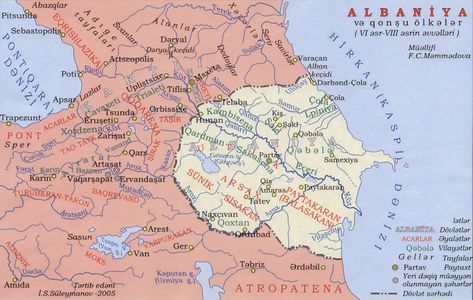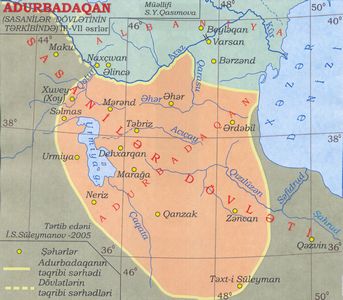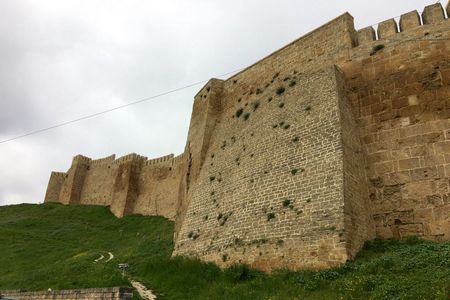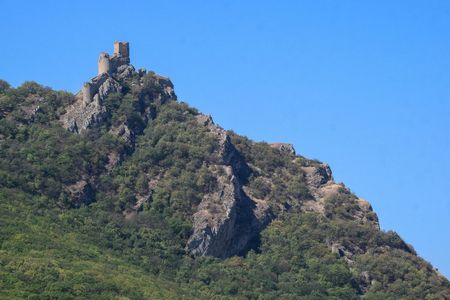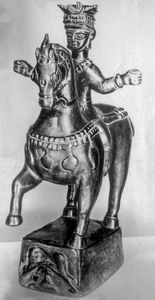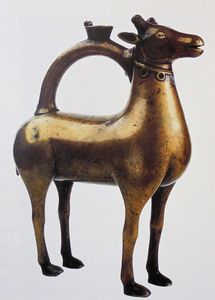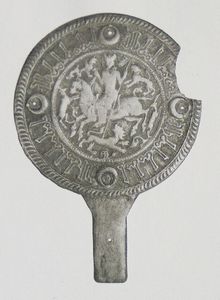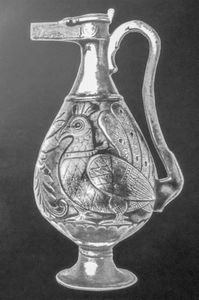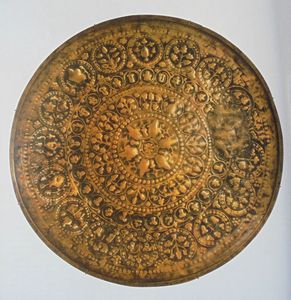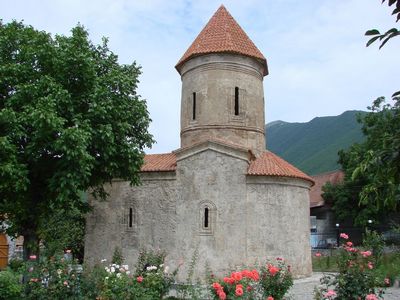AZERBAIJAN IN THE III-VIII CENTURIES
The emergence of new public relations. In the third century, Azerbaijan entered a new stage of socio-economic development. The main feature of this period is the dominance of feudal relations with the land, which is the main wealth of the country. The lands south of the Araz River were part of the Sassanid Empire, and the Albanian Arshaki dynasty was established in Albania, located north of the Araz River in Azerbaijan, in the middle of the first century.
POLITICAL HISTORY OF ALBANIA
As in ancient times, Albania included lands from the Caucasus Mountains in the north to the Araz River in the south, from Iberia in the west (the upper reaches of the Alazan and Iori rivers) to the Caspian Sea in the east. The capital of the Albanian state was Gabala until the 5th century.
The early medieval political history of Albania is divided into three periods: 1. The reign of the Arshak dynasty (from the middle of the 1st century to 510); 2. The period of Sassanid marzbanate (510 - 629); 3. The period of the Mehrani dynasty (630-705).
In the first century, Tsar Jasur Vachagan I united all the provinces of Albania into a single state. During the reign of the Albanian Tsar Urnayr (313-371), Christianity was declared the state religion and lands were donated to churches. Urnayr, an ally of the Sassanid ruler Shapur II, took part in the Roman-Sassanid wars with military force. Speaking on the side of the Sassanids, Urnayr's goal was to preserve the independence and territorial integrity of Albania. During the reign of Tsar Yesuage, the old Albanian alphabet was redesigned and the school network expanded. After completing the new version of the Albanian alphabet, Yesuagen focused on translating religious books from Greek into Albanian. During the reign of the ruler Vache II (444-463) the city of Partav (Barda) was built and the capital of the state was moved to this city. The reign of Tsar Vachagan III (487-510) is considered to be a period of political, cultural and religious revival in Albania. He brought back peasants and artisans who had escaped Sassanid oppression, created conditions for ordinary people to engage in peaceful labor, and agriculture, handicrafts, and trade began to flourish. Laws passed by the Church of Aquinas in 488 regulated the taxes and duties to be paid by secular and religious feudal peasants in Albania, especially those living on church lands.
The Sassanid Empire tried to abolish Albania as a state and annex its lands by various methods and means. The resettlement, taxation, and religious policies pursued by the Sassanids often led to riots in Azerbaijan and neighboring countries. Albanian uprising of 450 against the Sassanids, along with other Caucasian peoples, was led by the Albanian Catholicos. Although the rebels defeated the Sassanids in the Battle of Khalkhal in 450, they were severely defeated in the Battle of Avarayr in 451. The revolt against the Sassanids in Albania, Iberia, and elsewhere in 481-484 ended in victory.
In 485, Albania gained the right to self-government under the Treaty of Nwarsak, signed between the rebels and the Sassanid ruler Valash. The persecution of Christians was stopped, and the number of tax entering the Sassanid treasury from Albania was reduced. Atropatena, under Sassanid rule, began the Mazdak people's movement (481-529) in the 1980s. The main idea of the leader of the movement, Mazdak, was to distribute all blessings equally among the people. The people of Mazda fought to create property and social equality, to build a just society. Peasants, artisans, the urban poor and some nobles also took part in the movement. In 529, Shahenshah I Gubad ruthlessly suppressed the Mazdak movement.
From 510 to 629, Albania was ruled by Sassanid successors, the Marzbans. During this period, known as the "Great Marzbanate", the country's economy collapsed as Azerbaijan repeatedly became the scene of war between Byzantium and the Sassanids.
At the end of the 6th century - beginning of the 7th century, the Mehrani dynasty was strengthened in Albania. Representatives of this generation were related to the Sassanids and ruled the Albanian province of Girdman. During the reign of Varaz Gregor (630-642), Albania became close to the Sassanids, so he sent his son Javanshiri to help the Sassanids in the war against the Arabs. Javanshir returned to his homeland after fighting heroically for seven years as a commander in heavy fighting against the Arabs, and in 642 began to rule Albania.
The historian of the time, Moisey Kalankatli, in his History of Albania, described Javanshiri as a ruler who ruled the state with justice and focused all his efforts on the development and security of his country. It is reported that Javanshir built beautiful palaces and buildings in the country, patronized scientists, poets, scientists and cultural figures. The aim of Javanshir's foreign policy was to preserve the integrity and independence of Albania. Javanshir prevented the invasion of Albania by the Sassanid troops defeated by the Arabs and cleared the area of the Sassanids. The intensification of the Arab invasions of Albania forced Javanshiri to take refuge in a powerful state - Byzantium. Based on the strategic importance of Albania and aimed at securing its eastern borders in the face of Arab attacks, the Byzantine ruler Constantine II entered into a "sincere" alliance with Javanshir in 660. He sent Javanshir a golden throne, a sword adorned with pearls, and conferred on 1,200 Aghvan nobles the patriarchs and other high nobles.
In 662, Javanshir won the battle on the banks of the Kura River, preventing the Caspians from marching on Albania in search of gain. In 665, Javanshir went to the camp of the Caspians to stop the march of the Caspians to Albania with a large army, made peace with them and married the daughter of the Khagan. Javanshir returned 1,200 captive Albanians, many horses and cattle. As Byzantium weakened and the Arab state grew stronger, Javanshir began to draw closer to the Arabs. In 667, Javanshir, who was in the palace of the Arab caliph Muawiya in Damascus, accepted his vassal dependence on him and saved his country from war. In 670, he maintained Albania's internal independence by holding second diplomatic talks with the caliph.
In 680, Javanshir was assassinated by a Byzantine Albanian feudal lord. Gradually weakening, Albania was abolished as a state in 705, and the country was ruled by Arab emirs.
ALBANIAN ECONOMY
In the III-VII centuries, agriculture, cattle breeding and handicrafts were developing in Albania. The population was engaged in agriculture, growing grain, cotton, grapes, melons and gourds. In the early Middle Ages, the Albanian people plowed the land with bricks and shovels, sprinkled various grains on the ground, irrigated through artificial ditches, reaped with iron sickles and scythes, threshed thorns with hoes, collected grain in wells and jars, and used grain from boats. It was milled by hand mills from the 2nd century. There were also water mills in Albania. In widespread plowing, iron kotan, winter, sickle, etc. are used. tools were used. Albanian historian Moisey Kalankatli reported on the cultivation of valuable cotton varieties on the banks of the Kura. From Derbent to Tbilissi (Tbilisi), marena (golden dye), a dye plant, was grown. Grapes created a favorable environment for the development of winemaking. Albania's livestock economy was at a high level. In the early Middle Ages, Albanians were engaged in pastoral cattle breeding, raising cattle on alpine meadows in summer and lowering them on plains in winter. Large and small horned cattle, camels and horses were kept here.
Textile production developed on the basis of local raw materials (wool, linen, silk, cotton, etc.) became one of the important areas of handicrafts. Silk, wool, linen and high quality carpets were woven in Albania. As a result of archeological excavations in Mingachevir and Beylagan, looms weaving cloth and carpets were found. The metallurgical industry had reached a high level of development. Shirvan, Karabakh, Gadabay, Sheki-Zagatala and other regions played a central role in the production of metal products. One of the most developed arts was pottery. Woodworking, stone-cutting, leather, glass production, and other industries also flourished.
Along with the development of old ancient cities in Albania - Gabala, Nakhchivan, Derbent, new cities - Barda, Beylagan, etc. The process of formation and revival of city life was underway.
The Albanian capital, Partav (Barda), was one of the largest trade centers in the Middle East, located on caravan routes connecting the Persian Gulf, Central Asia, Byzantium, and the North Caucasus.
CULTURE IN ALBANIA
Significant changes in the material and spiritual culture of Albania in the early Middle Ages were associated with the development of urban life, the construction of architectural monuments and the spread of Christianity. During this time many fortresses, dams, palaces, churches and temples were built in the country. Such monuments include Torpaggala on the banks of the Alazan River, Govurgala in Aghdam, Javanshir Fortress in Ismayilli, Gilgilchay, Beshbarmag and Derbent dams, etc. shows that Albanian architecture is at a very high level. As Albania is one of the oldest centers of Christianity in the world, this religion has strongly influenced the spiritual life of the society. Albanians had their own script, their own calendar and their own schools. Albanian inscriptions found in Mingachevir are of special importance. It was determined that there are 62 letters on the stone cross base and about 140 letters on the other monuments (clay candlesticks, pots, etc.).
The Albanians first used the lunar calendar, and from the middle of the 4th century, the calendar typical of the Alexandrian school. In this calendar, the beginning of the year was taken as August 29.
There were schools in Albania in the 5th century. According to M. Kalankatli. The Albanian ruler Yesuagen ordered that children be sent to schools and taught to write, and that children be provided with food in schools.
CHRISTIANITY IN AZERBAIJAN
The first Christian communities in the northern part of Azerbaijan - Albania - appeared at the beginning of the first centuries AD, when the apostles and their disciples came here from Jerusalem and Syria. However, the adoption of Christianity as the state religion in 313 is associated with the name of the Albanian ruler Urnayr. However, the old beliefs - divinity, mania, Zoroastrianism - still remained among the population. The decisions of the Aquinas Council not only regulated the feudal foundations of the new religion, but also legitimized the persecution of previous religions. The development of the improved Albanian alphabet, the organization of schools, and the translation of the Bible and religious literature played a major role in the spread of Christianity. In connection with the conversion to Christianity, the central domed and basilic worship facilities appeared here. The basilica in the village of Gum in northwestern Azerbaijan, the circular temples in the villages of Boyuk Amili (Gabala) and Lakit (Gakh) are the first Christian monuments in Azerbaijan.
TYPES OF GRAVE MONUMENTS IN AZERBAIJAN IN THE EARLY MIDDLE AGES
Cube tombs
Are one of the most common types of graves in Albania and have been recorded in the Mil, Karabakh and Shirvan plains and in the foothills, on the banks of the Kura River. The custom of burying in cubes began in the second half of the first millennium, B.C. It lasted until the VIII century. Grave jars, which did not differ from household jars, were made for burial. The head of the deceased was placed on the side of the mouth of the jar. Inside the jar were small items, and around it were large clay pots and offerings. The mouth of the cube was covered with broken jars, flat stones or raw bricks. A bonfire was left at the mouth of the jar to purify it from evil forces. The cubes usually contained one, sometimes two, or even three people. The cubes were often buried on their sides, with the mouth facing north-west.
Catacomb tombs
Are ancient tombs dug by underground diversion. In Azerbaijan it has been known since the end of the first millennium B.C. and spread under the influence of Turkic-speaking Sarmatian and Massaget tribes. Catacombs are characterized by single, double and collective burials.
Earthen graves
Are one of the most common and ancient types of graves. It is mainly rectangular and oval in shape. The dead were buried more or less wrapped. Sometimes the tomb was 2 meters wide and 4 meters long. Household items and sacrifices were also placed in the tomb. Earth graves are located in Mingachevir, Yaloylutepe, Gabala, Khinisli, Chiragli, Nuydi, Girlartepe, Uzunboylar, Torpaggala, Kish, Shamkir and others. found in places.
Washtub graves
Burying in washtub graves was widespread in Ismayilli, Agsu, Gabala and Shamakhi regions of Azerbaijan from the 3rd century B.C. to the 2nd century AD. Clay vessels or coffins consisted of two parts connected by each other, with several small holes in the walls. Small clay pots differed from large ones in that they had two handles and no holes. The skeletons were folded and placed on the left or right side. Clay pots are found outside the tanks, and ornaments are found inside. There are traces of burnt wood at the head of the grave.
Well graves
Were discovered at the Khinisli monument in Shamakhi region. After placing the corpse and equipment in the graves, they covered it with wood. Gradually the trees rotted and the grave was filled with fine soil. Well graves It belongs to IV-I centuries b.c.
Raw brick tombs
Raw brick tombs are one of the types of graves found in Khanlar, Mingachevir and Jafarkhan (I century B.C. -II century AD). In these tombs, the dead were laid on their backs. Raw brick tombs bear traces of Turkish Sarmatian-Massaget tribes.
Wooden box graves
Were found only in Mingachevir. This type of tomb brought to Azerbaijan by the Turkic Sarmatian tribes dates back to the I-IV centuries AD. In these tombs, the dead were buried in pairs, face to face, folded, with their heads facing south-east. Burial equipment (clay vessels, weapons, silver cups, ornaments) was placed both inside and outside the wooden tomb. The tombs belonged to the nobility.
Stone statues
The art of transportation has been widespread in Azerbaijan since ancient times. In ancient and early medieval times, in the territory of Caucasian Albania, stone statues in the form of men were mostly made of local limestone based on the worldview of the population. They are reminiscent of ancient Turkish balbals and differed in shape and size. The Khinisli and Aghdam statues are very large, the Chiragli and Garibli statues are medium, and the Nargizava statues are small.
